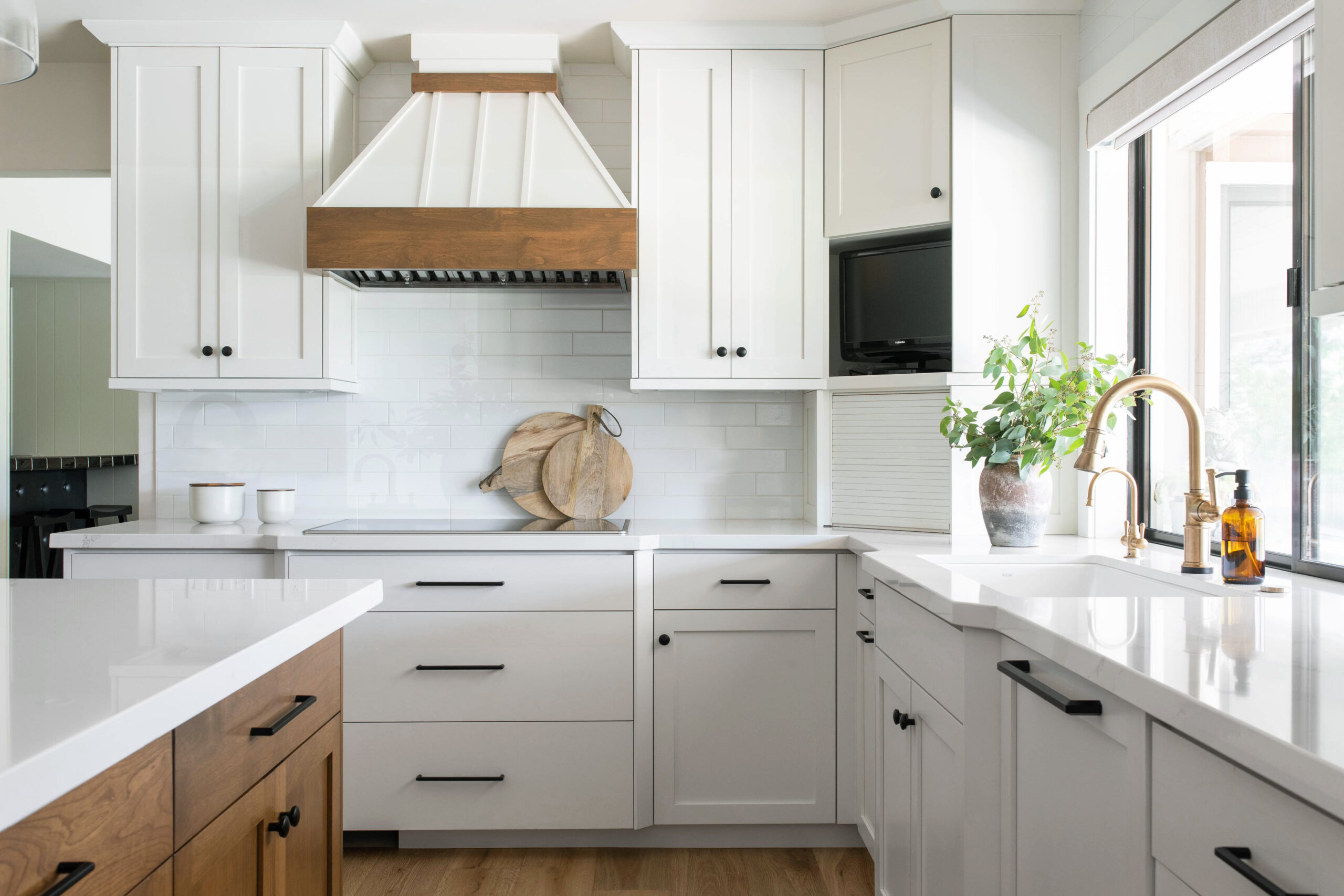Feeling a bit cramped in your living space? You’re not alone. Many of us dream of rooms that feel open, airy, and spacious. The good news? You don’t need to knock down walls or move to a bigger place to achieve that sense of roominess. The secret weapon might just be sitting on a shelf in your local hardware store: paint. In this article, we’ll explore which colors make a room look larger.
That’s right; the colors you choose for your walls can dramatically affect how large (or small) a room feels. It’s like optical illusion meets interior design–a bit of color psychology mixed with some clever visual tricks.
But here’s the question on everyone’s mind: which colors actually make a room look bigger? Is it all about going light and bright, or can darker hues play a role too? And how do you use these colors without turning your home into a bland box?
We’re about to dive into the wonderful world of space-enhancing colors. From light and airy to rich and bold, we’ll explore how different shades can transform your cozy nook into a space that feels much more generous.
So, grab a cup of coffee (or tea, if that’s more your style), and let’s talk paint. By the time we’re done, you’ll be looking at your rooms with fresh eyes–and maybe even a paintbrush in hand, ready to work some color magic.
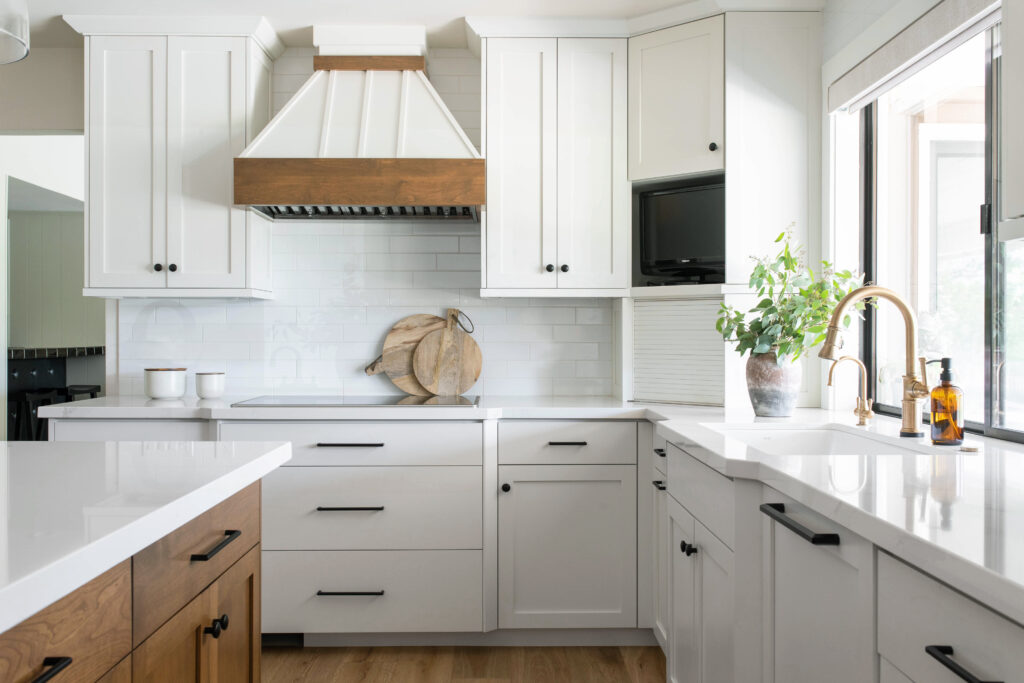
Colors that make a room look bigger
Ever wondered why some spaces feel like they go on forever while others feel like they’re closing in on you? The secret often lies in the paint can. Let’s pull back the curtain on the colors that can turn your snug space into a seemingly expansive haven.
Light and bright: The classic approach
It’s no secret that light wall colors are the go-to for making a room feel larger. But why? It’s all about light reflection, folks. Light hues bounce light around the room, blurring the edges of walls and creating an airy, open feel.
Here are some tried-and-true options:
- Crisp White: The ultimate space expander. It’s like erasing the boundaries of your room.
- Soft Gray: A bit of sophistication without the heaviness. Think of it as white’s cooler cousin.
- Pale Blue: Brings in a touch of sky, making your ceiling feel miles high.
- Light Green: A hint of nature that can make your space feel fresh and boundless.
Pro tip: Don’t just slap one color on all four walls and call it a day. Use variations of the same hue to add depth without shrinking your space. For example, paint your trim a shade lighter than your walls for a subtle, space-enhancing contrast.
Cool colors: The receding act
Cool colors have a nifty trick up their proverbial sleeves–they visually recede, making walls appear farther away. It’s like they’re playing hard to get with your eyes.
Some cool customers to consider:
- Soft Lavender: Adds a touch of whimsy while visually pushing walls outward.
- Pale Aqua: Brings in beachy vibes and makes your room feel like it stretches to the horizon.
- Light Periwinkle: A playful mix of blue and purple that adds interest without overwhelming.
Designer secret: Want to really amplify the effect? Paint your ceiling a shade lighter than your walls. It’s like lifting the lid off your room–an instant height boost!
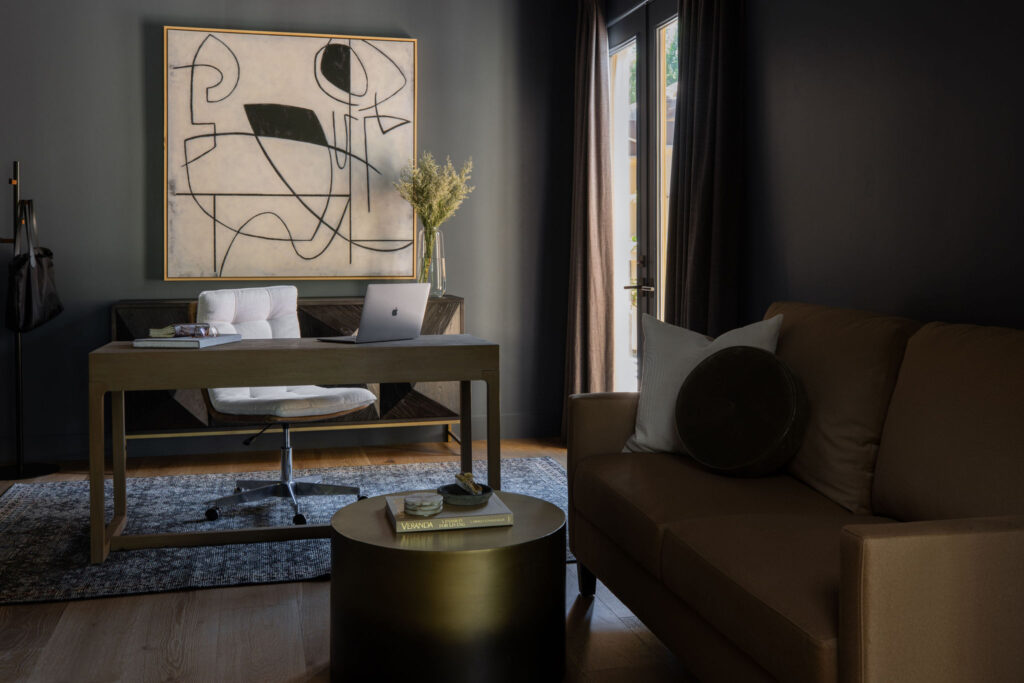
Do dark colors make a room look smaller?
We’ve all heard it, “Never use dark colors in a small room!” It’s practically interior design gospel. But here’s the thing–rules are made to be broken, especially with creative spaces.
While it’s true that dark colors can make walls appear closer, they don’t always shrink a room. In fact, used cleverly, dark hues can add depth, drama, and, yes, even spaciousness to a room.
Here’s how:
- Creating depth: Dark paint colors can make corners recede, potentially adding a sense of depth to a room.
- Blurring boundaries: A dark color on all walls can blur the edges of a room, making it harder to perceive where the space ends.
- Cozy vs. cramped: Sometimes, a small room painted dark can feel cozy and intimate rather than cramped.
When dark colors work to make a room look larger
- Rooms with lots of natural light can handle darker shades without feeling closed in.
- Spaces with high ceilings can be ‘grounded’ with darker walls, creating balance.
- Rooms used primarily in the evening (like dark-walled bedrooms) can feel luxurious and spacious.
Designer secret: Try painting one wall in a deep, rich color while keeping the others light. This can create the illusion of depth without overwhelming the space. It’s like adding an accent wall on steroids!
The dark color cheat sheet
If you’re ready to walk on the dark side, consider these space-enhancing darker hues:
- Navy Blue: Creates a sense of endless sky
- Charcoal Gray: Adds sophistication and depth
- Deep Emerald: Brings in nature and richness
- Burgundy: Adds warmth without closing in
Pro tip: When going dark, pay extra attention to your lighting. Good lighting can make or break a dark-colored room. Consider adding mirrors to reflect light and create the illusion of more space.
Read More>> Why is Kitchen Lighting So Hard to Get Right? (and How to Fix It)
The key to using dark colors in small spaces is balance. It’s not about avoiding dark colors altogether but about using them strategically.
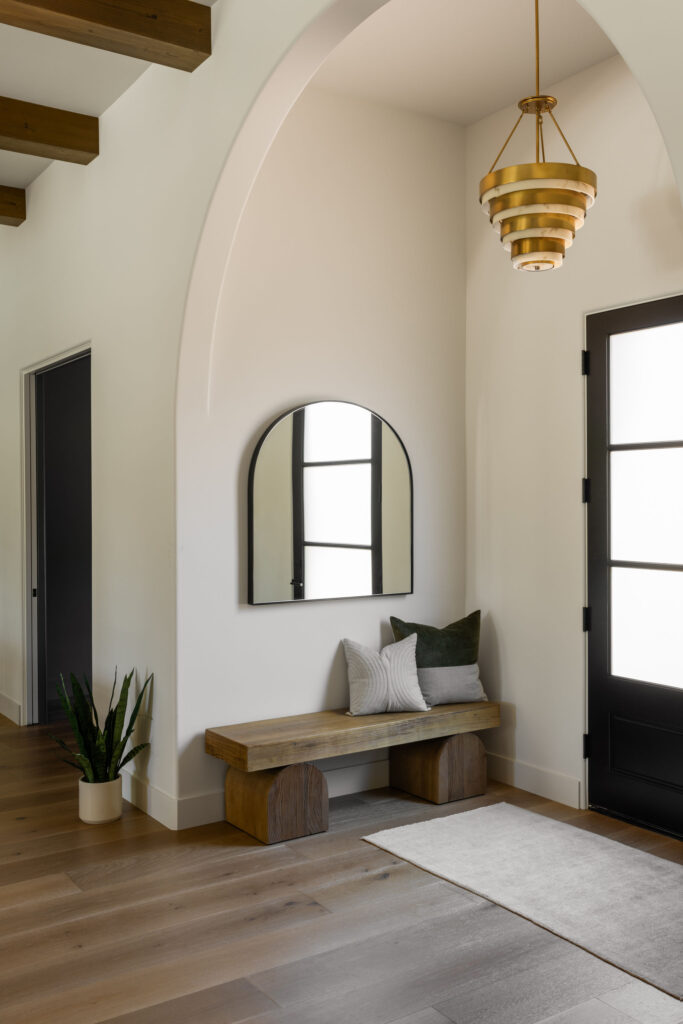
The magic of neutrals in expanding space
Think neutrals are boring? Think again! These versatile hues are the Swiss Army knives of the color world, especially in making a room look larger. Let’s dive into the neutral territory and see how these understated shades can work some serious spatial magic.
Why neutrals work
Neutrals are the chameleons of the color world. They play well with others, reflect light beautifully, and have a knack for making spaces feel open and airy.
Here’s why they’re so effective:
- Light reflection: Like their lighter cousins, neutrals bounce light around a room, helping to blur boundaries.
- Versatility: They create a perfect backdrop for other design elements without competing for attention.
- Continuity: Using similar neutrals throughout your home can create a sense of flow, making the entire space feel larger.
The neutral palette for making a room look larger
Not all neutrals are created equal. Here’s a rundown of some space-expanding favorites:
- Greige: The love child of gray and beige; it’s warm yet sophisticated.
- Taupe: A chameleon color that can lean warm or cool, depending on the light.
- Soft Cream: Warmer than white but just as space-enhancing.
- Light Khaki: Brings in a touch of nature without overwhelming the space.
Adding interest to neutral spaces
Texture and subtle variation are key to using neutrals without falling into the “boring” trap. Here are some tips:
- Layer different shades of the same neutral for depth.
- Use textured wallpaper or paint techniques to add visual interest.
- Incorporate natural elements like wood or stone to complement your neutral palette.
Designer secret: Try the “ombré wall” technique. Paint your walls in gradually darkening shades of the same neutral from floor to ceiling. It draws the eye upward, making your ceilings appear higher.
The power of monochromatic schemes for making a room look larger
A monochromatic color scheme using neutrals can be incredibly effective in using colors to make a room look larger. Using various shades and tints of the same color creates a cohesive look that doesn’t chop up the space visually.
Pro tip: When working with a neutral palette, don’t forget about your floors and ceiling. A continuous color flow from floor to ceiling can significantly expand your visual space.
Neutrals might not be flashy, but they’re certainly not boring when creating the illusion of space. They’re like the quiet kid in class who surprisingly has the best jokes–unassuming but full of pleasant surprises.
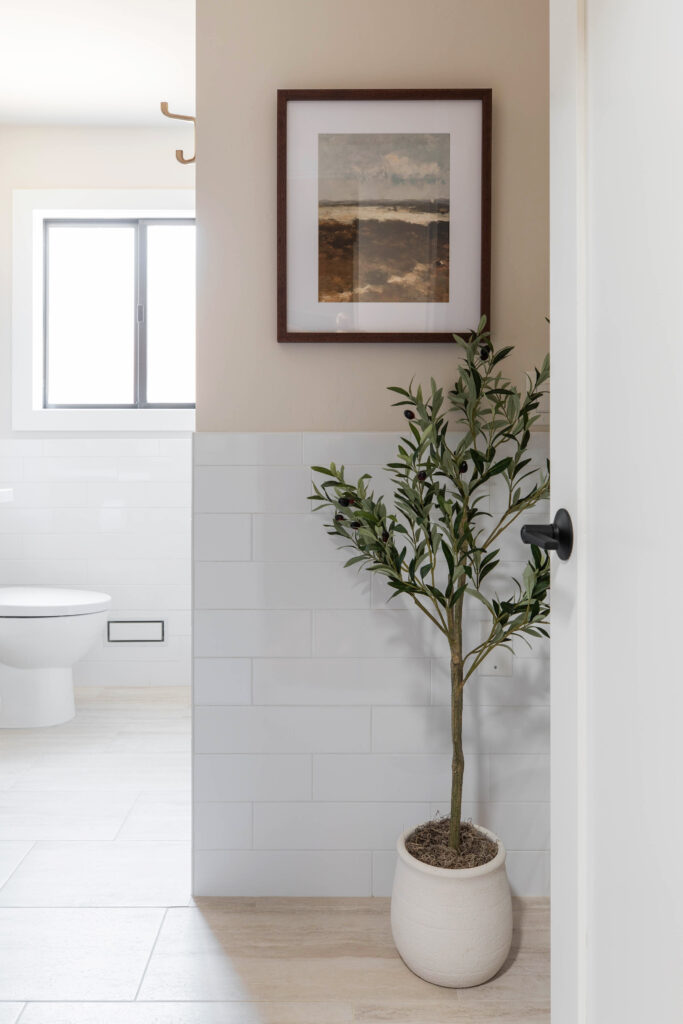
Painting rooms ideas for making a room look larger
Now that we’ve explored the colors that can make your rooms look larger, let’s roll up our sleeves and get into the nitty-gritty of how to use them. These painting ideas will help you maximize your space visually, turning even the coziest nook into a seemingly spacious retreat.
How to make rooms look taller
Want to make your ceilings appear higher? Try these tricks:
- Stripe it up: Vertical stripes aren’t just for fashion. Paint thin, vertical stripes on your walls to draw the eye upward.
- Two-tone technique: Paint the bottom third of your wall in a darker shade and the top two-thirds in a lighter one. It’s like giving your room a visual lift!
Pro tip: For an extra boost, paint your ceiling a shade lighter than your walls. It’s like giving your room a facelift without the hefty price tag.
How to make rooms look wider
Make your room appear wider with these clever painting ideas:
- The accent wall: Paint one wall in a slightly darker shade than the others. This can create the illusion of depth, making the room feel wider.
- Color blocking: Use two colors to create large rectangular shapes on your walls. This can trick the eye into seeing more space.
Designer secret: Paint your wall trim and moldings the same color as your walls. This creates an unbroken visual line, making your walls appear taller and your room larger.
How to make rooms look open
Even if you can’t knock down walls, you can create the illusion of an open concept:
- Color flow: Use the same color palette throughout adjacent rooms to create a sense of continuity.
- Ombré effect: Gradually lighten the shade of your chosen color as you move from one room to the next. It’s like creating a visual “fade” between spaces.
For small rooms
Got a particularly tiny space? Try these ideas:
- The fifth wall: Don’t forget about your ceiling! Painting it in an unexpected color can draw the eye upward, making the room feel larger.
- Mirror, mirror: While not strictly a painting technique, painting the wall behind a large mirror in a light, reflective color can amplify its space-enlarging effect.
Don’t forget to test
Before you commit to a color, always test it out. Here’s how:
- Paint large swatches on your walls and observe them at different times of day.
- Use peel-and-stick paint samples for a mess-free testing experience.
- Take photos of your swatches–sometimes colors look different in pictures, giving you a new perspective.
Painting is more than just slapping color on a wall. It’s about creating an experience, an atmosphere, and the illusion of space. So grab that paintbrush and get ready to expand your horizons–and your rooms!

Color psychology: Feeling spacious vs. actually looking bigger
Ever walked into a room and immediately felt at ease, like you could breathe easier? That’s color psychology at work. Certain colors can create a sense of openness and tranquility, even if they don’t necessarily make a room look bigger.
Here’s the lowdown:
- Blue: The color of the sky and sea, blue can make us feel unbounded and free.
- Green: Associated with nature, green can create a sense of harmony and expansiveness.
- Lavender: This soft purple hue is calming and can make a space feel serene and open.
The perception game
Our brains are fascinating organs, and they can sometimes play tricks on us when it comes to spatial perception. Here’s how:
- Cool colors (blues, greens, purples) tend to recede visually, making a space feel more open.
- Warm colors (reds, oranges, yellows) advance visually, potentially making a space feel cozier but not necessarily smaller.
Many interior designers agree that the goal isn’t always to make a room look as big as possible but to create a space that feels right for its purpose. A bedroom in deep, cool tones might feel more restful and spacious than one painted stark white, even if it doesn’t necessarily look larger.
Balancing act to make a room look and feel larger
The key is to find the sweet spot between visual spaciousness and emotional comfort. Here are some tips:
- Consider the room’s purpose: A home office might benefit from energizing yet visually receding colors like soft green or pale blue.
- Think about natural light: Rooms with less natural light might feel more spacious with warmer, creamier tones rather than stark white.
- Don’t forget about personal preference: A color that makes you feel good will ultimately make the space feel more open and inviting.
Pro tip: If you love warm colors but want to maintain a sense of spaciousness, try using them as accents against a cooler backdrop.
The power of associations
Our personal experiences with colors can greatly influence how we perceive space. For example:
- If you grew up in a home with a large, airy living room painted light blue, you might associate that color with spaciousness.
- If your favorite relaxation spot is a green park, green tones might make you feel unconfined and at ease.
While there are general guidelines, the most important thing is how a color makes you feel in your space. After all, a room that feels good to you will always seem more spacious than one that doesn’t, regardless of its actual size.
Let’s get started
We’ve painted quite a picture, haven’t we? From light and airy to deep and dramatic, we’ve explored how colors can transform your space from snug to spacious–at least in appearance and feel.
Let’s recap our key points:
- Light colors are classic space-expanders, reflecting light and blurring boundaries.
- Cool colors can make walls appear to recede, creating a sense of depth.
- Dark colors, contrary to popular belief, can sometimes make a room feel larger when used strategically.
- Neutrals are versatile space-enhancers, offering a perfect backdrop for other design elements.
- Painting techniques like vertical stripes or two-tone walls can create illusions of height and width.
- Color psychology plays a crucial role in how spacious a room feels, not just how it looks.
There’s no one-size-fits-all solution when it comes to color and space. What works in one room might not work in another, and personal preference plays a big role. The key is experimenting and finding what makes you feel comfortable and unconfined in your space.
Don’t be afraid to play with color! Start small if you’re hesitant–maybe an accent wall or even just new throw pillows in a space-enhancing hue. And always, always test your colors before committing to a full room makeover.
Ultimately, the best colors for making a room look larger is one that you love coming home to. After all, a space that brings you joy will always feel more open and inviting, no matter its actual square footage.
If you’re curious about how professional designers approach color selection for entire homes, check out our article on interior designers’ strategies for choosing home color palettes. And if you’re wondering whether your interior color choices need to align with your home’s exterior, don’t miss our piece on balancing interior design with exterior architecture.
At Jennifer Ramsey Interiors, we’re passionate about helping you create a home that feels spacious, comfortable, and uniquely you. Whether you’re ready to dive into a bold new color scheme or just need a little guidance on choosing the perfect shade to expand your space, we’re here to help.
Contact us today, and let’s work together to bring your space-expanding color dreams to life. We’ll help you navigate the world of color psychology, painting techniques, and space planning to create a home that’s visually larger and perfectly suited to your lifestyle.
